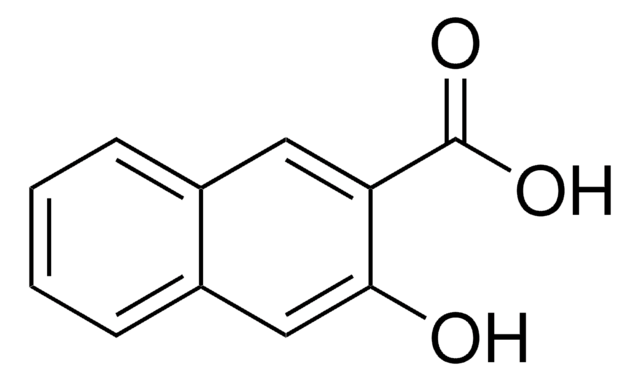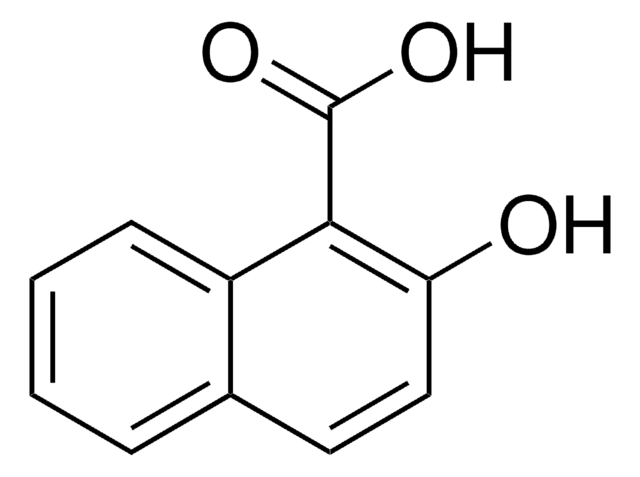281255
1,4-Dihydroxy-2-naphthoic acid
97%
Synonym(s):
1,4-Dihydroxy-2-carboxy naphthoic acid, 1,4-Dihydroxy-2-naphthalenecarboxylic acid, 1,4-Dihydroxy-2-naphthoate
Sign Into View Organizational & Contract Pricing
All Photos(2)
About This Item
Linear Formula:
(HO)2C10H5CO2H
CAS Number:
Molecular Weight:
204.18
EC Number:
MDL number:
UNSPSC Code:
12352100
PubChem Substance ID:
NACRES:
NA.22
Recommended Products
Quality Level
Assay
97%
mp
220 °C (dec.) (lit.)
functional group
carboxylic acid
SMILES string
OC(=O)c1cc(O)c2ccccc2c1O
InChI
1S/C11H8O4/c12-9-5-8(11(14)15)10(13)7-4-2-1-3-6(7)9/h1-5,12-13H,(H,14,15)
InChI key
VOJUXHHACRXLTD-UHFFFAOYSA-N
Related Categories
General description
1,4-Dihydroxy-2-naphthoic acid from Propionibacterium freudenreichii is known to promote the proliferation of Bifidobacterium. It has potential therapeutic application for psoriasis treatment.
Signal Word
Warning
Hazard Statements
Precautionary Statements
Hazard Classifications
Eye Irrit. 2 - Skin Irrit. 2 - STOT SE 3
Target Organs
Respiratory system
Storage Class Code
11 - Combustible Solids
WGK
WGK 3
Flash Point(F)
Not applicable
Flash Point(C)
Not applicable
Personal Protective Equipment
dust mask type N95 (US), Eyeshields, Gloves
Choose from one of the most recent versions:
Already Own This Product?
Find documentation for the products that you have recently purchased in the Document Library.
Customers Also Viewed
M Matsubara et al.
Osteoporosis international : a journal established as result of cooperation between the European Foundation for Osteoporosis and the National Osteoporosis Foundation of the USA, 21(8), 1437-1447 (2009-10-09)
The main component of the metabolic by-products of fermentation by Propionibacterium freudenreichii ET-3 is 1,4-dihydroxy-2-naphthoic acid (DHNA), which has a naphthoquinone skeleton, as in vitamin K2. This study showed that DHNA improved bone mass reduction with osteoporosis model mice caused
Masayuki Uchida et al.
Regulatory toxicology and pharmacology : RTP, 60(2), 262-267 (2010-12-22)
Propionibacterium freudenreichii ET-3 (7025) culture, a cell-free product of whey fermentation by P. freudenreichii ET-3, has been shown to promote the growth of Bifidobacteria through the action of 1,4-dihydroxy-2-naphthoic acid (DHNA). Here we report the results of two clinical studies
Jincai Ma et al.
Environmental microbiology, 11(1), 149-158 (2008-09-25)
In this study, we investigated the role of menaquinone biosynthesis genes in selenate reduction by Enterobacter cloacae SLD1a-1 and Escherichia coli K12. A mini-Tn5 transposon mutant of E. cloacae SLD1a-1, designated as 4E6, was isolated that had lost the ability
D J Shaw et al.
Journal of bacteriology, 152(3), 1132-1137 (1982-12-01)
Four independent menaquinone (vitamin K(2))-deficient mutants of Escherichia coli, blocked in the conversion of o-succinylbenzoate (OSB) to 1,4-dihydroxy-2-naphthoate (DHNA), were found to represent two distinct classes. Enzymatic complementation was observed when a cell-free extract of one mutant was mixed with
Y Saito et al.
Journal of biochemistry, 89(5), 1445-1452 (1981-05-01)
1,4-Dihydroxy-2-naphthoate:polyprenyltransferase was detected in the membrane fraction from Micrococcus luteus. The specificity of the enzyme ws so tolerant as regards the prenyl-donating substrate that prenyl pyrophosphates ranging in chain length from C15 to C45 were active as substrates. The monophosphate
Our team of scientists has experience in all areas of research including Life Science, Material Science, Chemical Synthesis, Chromatography, Analytical and many others.
Contact Technical Service













